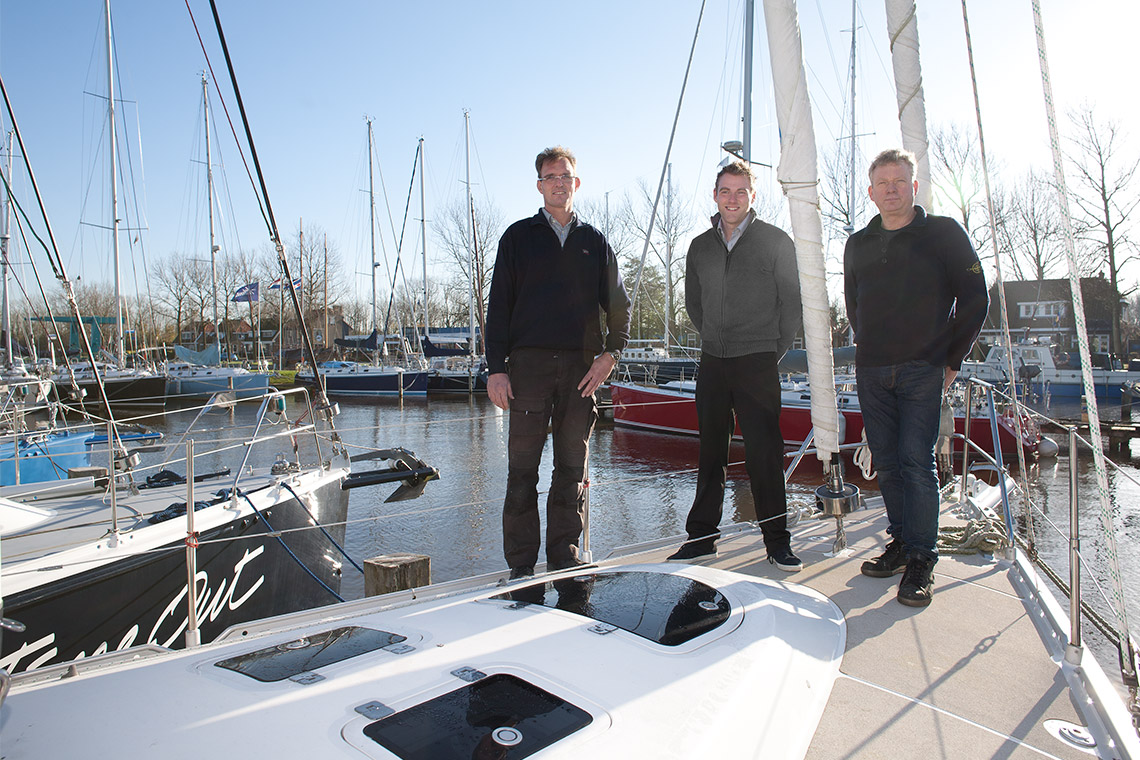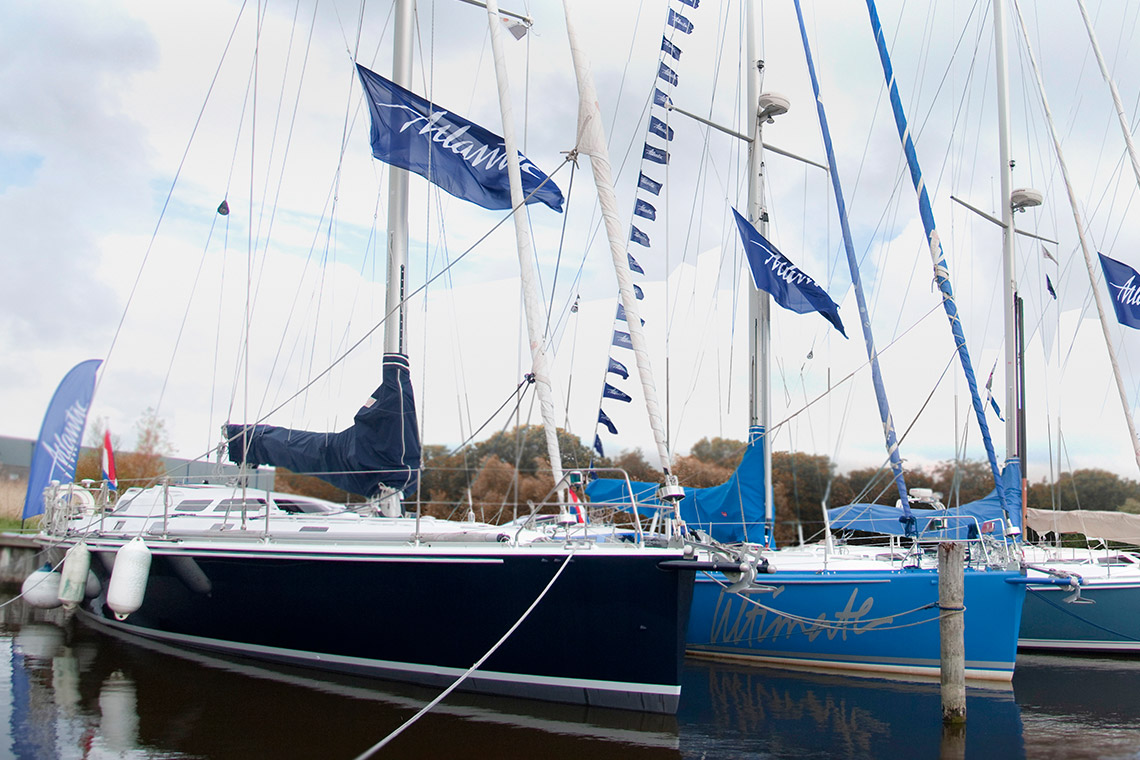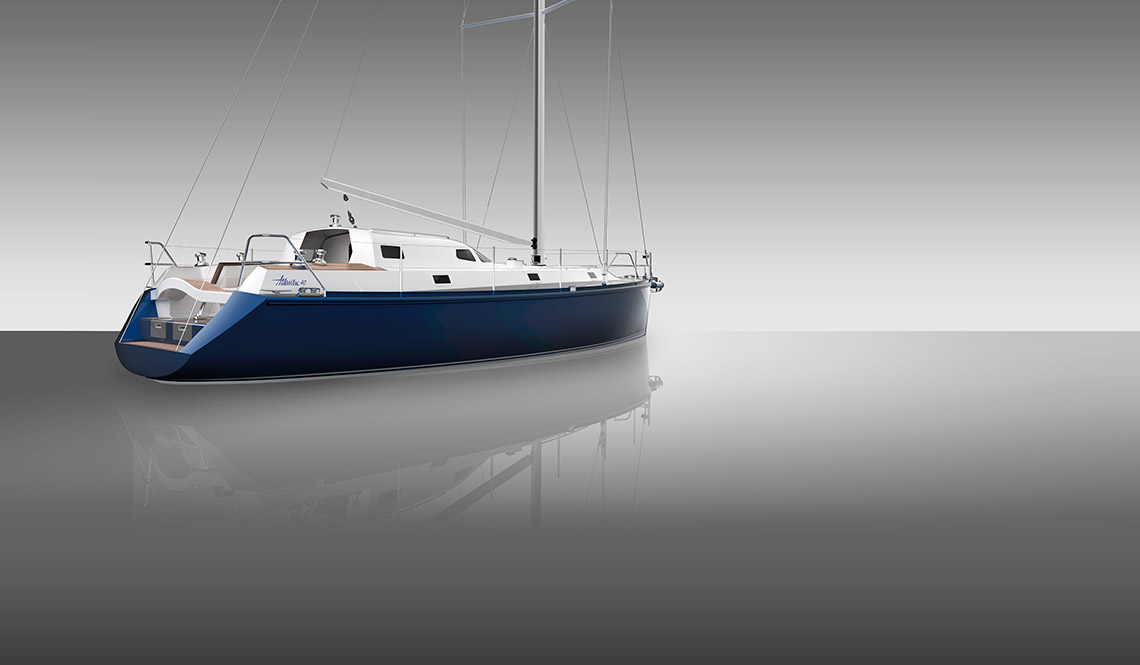"design – the basis for our process.”
An interview with Fimme Baarda and Wessel Veenstra, working at Atlanticyachts, and Sören Knittel, nexus product design.
At Atlantic ships are built manually with great attention to details. This builds the basis for new thinking and making which results in a solid management of design with mutual aim to turn handcraft, construction, architecture and design into manufactured making. The first result is the “Atlantic 40feet series”.
Harlingen welcomes us with sunshine. The wind blows with 6 Bft to northwest. Numerous sailing boats are floating in the shipyard’s own marina. Among them several Atlantic boats. This place embodies the gate to freedom and independence for their owners.
Teak parquet is laid inside the administration office. The president, who is also Atlantic’s technical director, has a folder of construction plans lying on his desk, next to some sketches and several pens. On the back of his chair rests a heavy sailing jacket, ready to be picked up. Next to it waits a carefully wrapped, brand new Andersen-winch for a customer’s boat. CEO and sales manager Fimme Baarda is sitting opposite. Behind his desk hangs a big board with keys that give access to all the boats lying in the marina.


Nexus: Mr Baarda, for starters, tell us something about the shipyard’s marina.
Fimme Baarda: We took this shipyard over from founder Leo van Oostenbrugge. At that time Leo was a pioneer of constructing high performance aluminium sailing yachts. We had worked with him several years before, too. Wessel was his technician and I was responsible for the sale. We constructed these models together with Dick Zaal and our customers.
Nexus: Leo was a pioneer of aluminium construction. What is his philosophy?
Fimme Baarda: He was – and still is – sailing around the world. He had a vision of ships with adjustable draught, which are able to master every situation at sea and on the contrary are able to fall dry before Vlieland at mudflat. Furthermore the vision of sailing yachts which cross the Atlantic Ocean twice and return with no damage. This is still our guideline and we are successful with it.
Nexus: Mr Veenstra, could you tell us a little more about the technical terms within this philosophy?
Wessel Veenstra: The standards we set and that are set by our customers require innovations. All our sailing yachts’ components are designed to offer safety, rigidity and comfort. We also set these standards for our suppliers.
Our contemporary models are entirely custom-made. This means that the basis consists of the hulk with keel, the entire deck and the cockpit. All these are intrinsically connected with each other. The construction of the keel, the electrical system, the interior and extensional mounting, such as the mast, are crafted and build in to size.
Our customers, the people who order one of our sailing yachts have a dream they want to live. They know what they want because most of them are experienced sailors. The technical conversion is a challenge and we have to spread our boundaries again and again. The construction takes place as a confidential dialogue between the architect, the costumer and us.
Nexus: We have defined a way for the future with our design of the “Atlantic 40feet series”. How did it come to this corporation from your perspective?
Fimme Baarda: The developing process leading to an Atlantic-Yacht is complex, as Wessel just described. But the process will end with a unique product, that’s for sure.
As developers we have to think about ways to ensure long-time quality without any compromises but as efficiently as possible. We worked with a group of external engineers two years before we knew nexus and analysed our production process with them. This improved our comprehension of our work and led us to passing the following job on to you.
Nexus: You gave us complete freedom in terms of analysing, collecting approaches and developing concepts. What was especially important to you?
Fimme Baarda: Our products have their own guideline. We worked hard in order to build yachts that are different and better for our customers. We differentiate ourselves from our competitors and it is enormously important to us to find intelligent and better solutions. We want to keep up tradition but see new perspectives. Thinking out of the box is important to us.

Nexus: The approach to our design-strategy for the new models is a synergy of innovation and emotion in order to maximise, not only the yacht’s safety and comfort, but also its manoeuvrability. On the other hand we then either integrated things or let them out at different places. How do such steps affect the company?
Fimme Baarda: We believe that the value and the precise size of a sailing yacht will no longer rely on its amount of separated cabins underneath the deck. The “Atlantic 40feet series” shows the way we want to solve this in future. As an example: To offer models with a fixed keel was a big step for us, which we had to evaluate in terms of ethic values. Is it still an Atlantic? And we agreed on yes, it still is. However it is thought differently and a valuable addition to our portfolio.
Nexus: Speaking of the space underneath the deck: our vision consists of a reduced, warm and intelligent interior. We tried to include this in the “Atlantic 40feet series” in form of a new, modular structure of building. What do you expect from this?
Wessel Veenstra: The concept’s structure is very interesting and marks the future direction. With this we will work with new production processes, which enable us to produce faster and easier. The design is the foundation of our process in order to use this efficiency. The Atlantic 40 series is our example for the fact that a sailing yacht exists before we produce it. But whether it keeps its promise is something we can only find out after it has been built.
Fimme Baarda: This structure is also a method to communicate. During the production process we have the ability to display capabilities and boundaries in order to discuss these in an early state of production. We can offer our unique characteristics with more flexibility and therefore appeal to a wider range of costumers.
Nexus: To conclude our talk. In what ways will design affect the future of Atlantic?
Wessel Veenstra: Our customers care about their sailing yacht. Often thought to be a second home for wherever they want to be. In our relationship with them we still want to be manufacturers and their hailing port. Design is the economical junction where it all comes together and from where on important steps are going to be developed.
Fimme Baarda: Yes, indeed. With design as a process we are able to evaluate innovations and use them systematically. They have to work invisibly.
Nexus: Thank you very much for your time and this great final word!
We leave the city alongside a canal with picturesque buildings with crow-stepped gables. Going back south on the “A6”. It seems that there is no such thing as commuter traffic here at this time. Friesland’s flat landscape and the wide horizon remind us of our project’s philosophy. With this feeling and new inspiration we look forward to our next visit at Atlantic and further interesting projects.
“An Atlantic sailing yacht may truthfully call itself a ship.”

